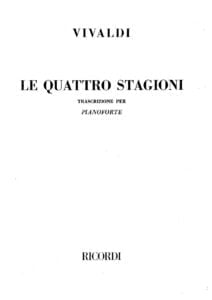The 100 most inspiring musicians of all Time: Antonio Vivaldi
Antonio Vivaldi (b. March 4, 1678, Venice, Republic of Venice [Italy]—d. July 28, 1741, Vienna, Austria)
Antonio Lucio Vivaldi was an Italian composer and violinist who left a decisive mark on the form of the concerto and on the style of late Baroque instrumental music.
Life
Vivaldi’s main teacher was probably his father, Giovanni
Battista, who in 1685 was admitted as a violinist to the
orchestra of the San Marco Basilica in Venice. Antonio,
the eldest child, trained for the priesthood and was ordained
in 1703.
He made his first known public appearance playing
violin alongside his father in the basilica in 1696. He became
an excellent violinist, and in 1703 he was appointed violin
master at the Ospedale della Pietà, a home for abandoned
or orphaned children. The Pietà specialized in the musical
training of its female wards, and those with musical aptitude
were assigned to its excellent choir and orchestra.
Vivaldi had dealings with the Pietà for most of his career:
as violin master (1703–09; 1711–15), director of instrumental
music (1716–17; 1735–38), and paid external supplier of
compositions (1723–29; 1739–40).
Vivaldi’s earliest musical compositions date from his
first years at the Pietà. Printed collections of his trio
sonatas and violin sonatas respectively appeared in 1705
and 1709, and in 1711 his first and most influential set of
concerti for violin and string orchestra (Opus 3, L’estro
armonico) was published by the Amsterdam music-publishing
firm of Estienne Roger. In the years up to 1719, Roger published
three more collections of his concerti (opuses 4, 6,
and 7) and one collection of sonatas (Opus 5).

Vivaldi made his debut as a composer of sacred vocal
music in 1713, when the Pietà’s choirmaster left his post
and the institution had to turn to Vivaldi and other composers
for new compositions. He achieved great success
with his sacred vocal music, for which he later received
commissions from other institutions. Another new field
of endeavour for him opened in 1713 when his first opera,
Ottone in villa, was produced in Vicenza. Returning to Venice,
Vivaldi immediately plunged into operatic activity in the
twin roles of composer and impresario.
From 1718 to 1720 he worked in Mantua as director of secular music for that city’s governor, Prince Philip of Hesse-Darmstadt.
This was the only full-time post Vivaldi ever held; he seems to have preferred life as a freelance composer for the flexibility and entrepreneurial opportunities it offered.
Vivaldi’s major compositions in Mantua were operas, though he
also composed cantatas and instrumental works.
The 1720s were the zenith of Vivaldi’s career. Based
once more in Venice, but frequently traveling elsewhere,
he supplied instrumental music to patrons and customers
throughout Europe. Between 1725 and 1729 he published
five new collections of concerti (opuses 8–12).
After 1729 Vivaldi stopped publishing his works, finding it more profitable to sell them in manuscript to individual purchasers.
In the 1730s Vivaldi’s career gradually declined. The
French traveler Charles de Brosses reported in 1739 with
regret that his music was no longer fashionable. Vivaldi’s
impresarial forays became increasingly marked by failure.
In 1740 he traveled to Vienna, but he fell ill and did not
live to attend the production there of his opera L’oracolo in
Messenia in 1742. The simplicity of his funeral on July 28,
1741, suggests that he died in considerable poverty.
Instrumental Music
Almost 500 concerti by Vivaldi survive. More than 300 are
concerti for a solo instrument with string orchestra and
continuo. Of these, approximately 230 are written for solo
violin, 40 for bassoon, 25 for cello, 15 for oboe, and 10 for
flute. There are also concerti for viola d’amore, recorder,
mandolin, and other instruments. Vivaldi’s remaining
concerti are either double concerti (including about 25
written for two violins), concerti grossi using three or
more soloists, concerti ripieni (string concerti without a
soloist), or chamber concerti for a group of instruments
without orchestra.
Vivaldi perfected the form of what would become the
Classical three-movement concerto. Indeed, he helped
establish the fast-slow-fast plan of the concerto’s three
movements. Perhaps more importantly, Vivaldi was the
first to employ regularly in his concerti the ritornello form,
in which recurrent restatements of a refrain alternate with
more episodic passages featuring a solo instrument.
Vivaldi’s bold juxtapositions of the refrains (ritornelli) and
the solo passages opened new possibilities for virtuosic
display by solo instrumentalists.
The fast movements in his concerti are notable for their rhythmic drive and the boldness of their themes, while the slow movements often
present the character of arias written for the solo instrument.
Several of Vivaldi’s concerti have picturesque or allusive
titles. Four of them, the cycle of violin concerti entitled
The Four Seasons (Opus 8, no. 1–4), are programmatic in a
thoroughgoing fashion, with each concerto depicting a different
season of the year, starting with spring. Vivaldi’s
effective representation of the sounds of nature inaugurated
a tradition to which works such as Ludwig van
Beethoven’s Pastoral Symphony belong. Vivaldi also left more
than 90 sonatas, mainly for stringed instruments.
Vocal Music
More than 50 authentic sacred vocal compositions by
Vivaldi are extant. They range from short hymns for solo
voices to oratorios and elaborate psalm settings in several
movements for double choir and orchestra. He composed
some 50 operas (16 of which survived in their entirety) as
well as nearly 40 cantatas. Many of Vivaldi’s vocal works
exhibit a spiritual depth and a command of counterpoint
equal to the best of their time. Moreover, the mutual
independence of voices and instruments often anticipates
the later symphonic masses of Joseph Haydn and Wolfgang
Amadeus Mozart.
